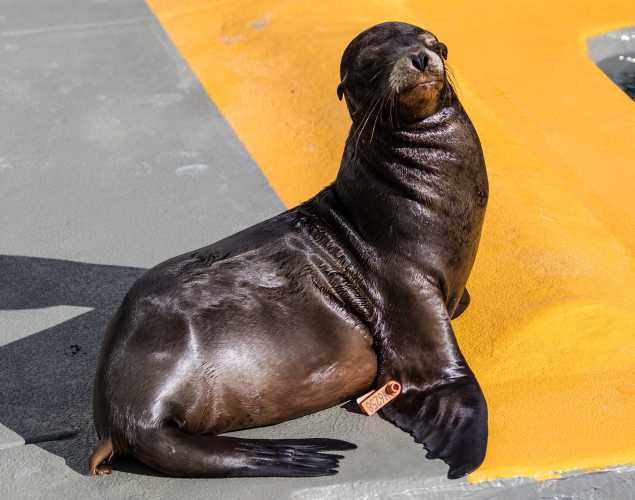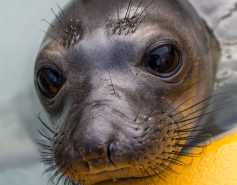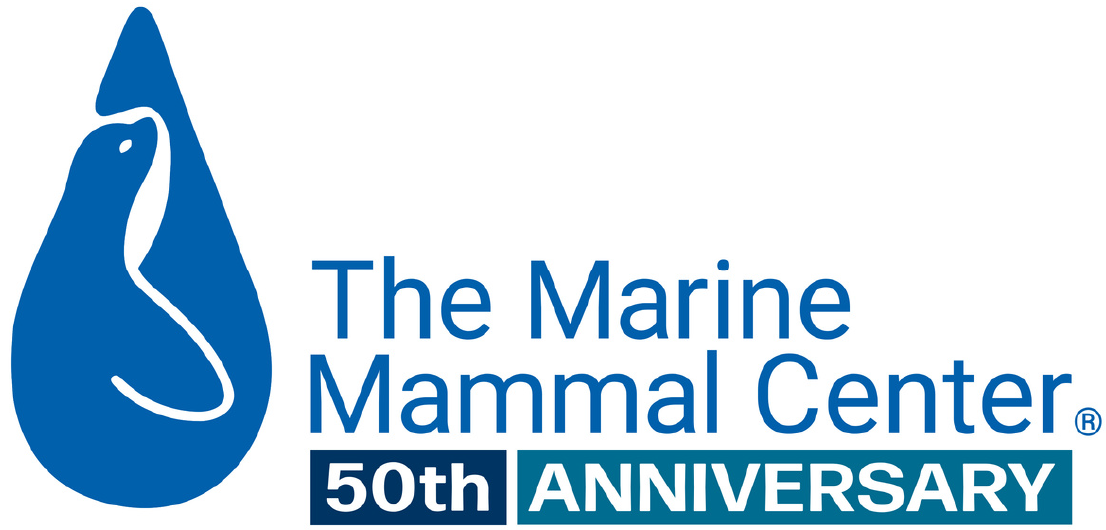
Intraperitoneal Dextrose Administration to Northern Fur Seal Pups in Hypoglycemic Crisis
- Malnutrition
- Medicine
Abstract
The Marine Mammal Center (TMMC) cares for malnourished California sea lion (CSL) (Zalophus californianus) pups and yearlings every year. Hypoglycemia is a common consequence of malnutrition in young CSLs. Administering dextrose during a hypoglycemic crisis is vital to recovery. Traditional veterinary approaches to treat hypoglycemia pose therapeutic challenges in otariids, as vascular access and catheter maintenance can be difficult. The current approach to a hypoglycemic episode at TMMC is to administer dextrose intravenously (i.v.) by medically trained personnel. Intraperitoneal (i.p.) dextrose administration is an attractive alternative to i.v. administration because volunteer staff with basic training can administer treatment instead of waiting for trained staff to treat. This study compares the effects of i.v., i.p., and no dextrose administration on serum glucose and insulin in clinically healthy, euglycemic CSL yearlings. Three groups of animals, consisting of five sea lions each, were treated with 500 mg/kg dextrose using one of the following routes: i.v., i.p., or no dextrose (control). A jugular catheter was placed, and blood samples were collected at times 0, 5, 15, 30, 60, 120, 180, and 240 min after dextrose administration. I.v. dextrose administration resulted in an increase of serum glucose concentrations from a baseline level of approximately 150 mg/dl to a peak of approximately 350 mg/dl. The resulting hyperglycemia persisted for approximately 2 hr and was associated with an attenuated plasma insulin response compared with most terrestrial mammals. Intraperitoneal dextrose administration resulted in increases of serum glucose to approximately 200 mg/dl, which gradually declined to baseline by 2 hr after dextrose administration. These data suggest that the initial treatment of a hypoglycemic crisis in young malnourished CSLs can be accomplished with i.p. dextrose, thus enabling minimally trained volunteer staff to respond immediately to a crisis. Further studies are needed to determine the most appropriate long-term treatment.
Fravel, V.A., Van Bonn, W., Gulland, F., Rios, C., Fahlman, A., Graham, J.L., Havel, P.J. (2016). Intraperitoneal dextrose administration as an alternative emergency treatment for hypoglycemic yearling California sea lions (Zalophus californianus). Journal of Zoo and Wildlife Medicine 47(1): 76-82.
Related Publications
{"image":"\/Animals\/Patients\/Elephant seals\/cropped-images\/es-by-bill-hunnewell-c-the-marine-mammal-center-3-2-1214-3454-3512-1600891002.jpg","alt":"northern elephant seal","title":"Diagnostic Tests for Lungworm-Infected Northern Elephant Seals","link_url":"https:\/\/www.marinemammalcenter.org\/publications\/diagnostic-tests-for-lungworm-infected-northern-elephant-seals","label":"Research Paper"}

{"image":"\/Animals\/Patients\/California sea lions\/cropped-images\/csl-by-bill-hunnewell-c-the-marine-mammal-center-7-0-1446-2827-2208-1603918668.jpg","alt":"California sea lion on pool ledge","title":"Effectiveness of Antibiotics in Treating Leptospirosis in California Sea Lions","link_url":"https:\/\/www.marinemammalcenter.org\/publications\/effectiveness-of-antibiotics-in-treating-leptospirosis-in-california-sea-lions","label":"Research Paper"}

Effectiveness of Antibiotics in Treating Leptospirosis in California Sea Lions
Read More{"image":"\/Animals\/Wild\/Elephant seal\/cropped-images\/elephant-seal-bull-shutterstock-640-0-3728-2911-1626818513.jpg","alt":"large northern elephant seal on a beach","title":"Use of Potassium Chloride for Low-Residue Euthanasia of Anesthetized Seals and Sea Lions","link_url":"https:\/\/www.marinemammalcenter.org\/publications\/use-of-potassium-chloride-for-low-residue-euthanasia-of-anesthetized-seals-and-sea-lions","label":"Research Paper"}

Use of Potassium Chloride for Low-Residue Euthanasia of Anesthetized Seals and Sea Lions
Read More{"image":"\/Animals\/Wild\/Other species\/cropped-images\/weddell-seal-shutterstock-256-0-3788-2959-1639535584.jpg","alt":"Weddell seal laying on the ice","title":"A Safe and Effective Reversible Field Sedation Protocol for Weddell Seal Pups","link_url":"https:\/\/www.marinemammalcenter.org\/publications\/a-safe-and-effective-reversible-field-sedation-protocol-for-weddell-seal-pups","label":"Research Paper"}

A Safe and Effective Reversible Field Sedation Protocol for Weddell Seal Pups
Read MoreRelated News
{"image":"\/Animals\/Patients\/Elephant seals\/cropped-images\/es-hoffman47927-photo-by-bill-hunnewell-c-the-marine-mammal-center-124-0-1270-992-1748384535.jpg","alt":"An An elephant seal\u2019s face with long black whiskers and wide eyes emerges from the water. ","title":"Adaptations of the Deep: Seal Whiskers and Eyes","link_url":"https:\/\/www.marinemammalcenter.org\/news\/adaptations-of-the-deep-seal-whiskers-and-eyes","label":"Patient Update","date":"2025-05-28 02:00:00"}

{"image":"\/Animals\/Wild\/Elephant seal\/cropped-images\/01. SNI Andromeda_NOAA permit-174-0-1270-992-1733414759.jpg","alt":"A northern elephant seal with a satellite tag on its head on the beach in front of crashing waves. ","title":"Studying Elephant Seals of the Central California Coast","link_url":"https:\/\/www.marinemammalcenter.org\/news\/studying-elephant-seals-of-the-central-california-coast","label":"News Update","date":"2024-12-06 12:21:47"}

{"image":"\/Animals\/Patients\/California sea lions\/2022\/cropped-images\/csl-torple-by-bill-hunnewell-c-the-marine-mammal-center-6-10-4475-3495-1664989112.jpg","alt":"California sea lion Torple in a pool with her head in the air","title":"SFGATE: Hundreds of Sea Lions Sickened Along California Coastline","link_url":"https:\/\/www.marinemammalcenter.org\/news\/sfgate-hundreds-of-sea-lions-sickened-along-california-coastline","label":"In the News","date":"2022-10-05 02:00:00"}

SFGATE: Hundreds of Sea Lions Sickened Along California Coastline
October 5, 2022
Read More{"image":"\/Animals\/Patients\/California sea lions\/2014\/cropped-images\/csl-orchard-photo-c-the-marine-mammal-center-1350-74-2950-2304-1713994848.jpg","alt":"California sea lion Orchard","title":"The Curious Case of the Sea Lion That Couldn\u2019t Catch His Breath","link_url":"https:\/\/www.marinemammalcenter.org\/news\/the-curious-case-of-the-sea-lion-that-couldnt-catch-his-breath","label":"Patient Update","date":"2014-11-19 01:00:00"}

The Curious Case of the Sea Lion That Couldn’t Catch His Breath
November 19, 2014
Read More
